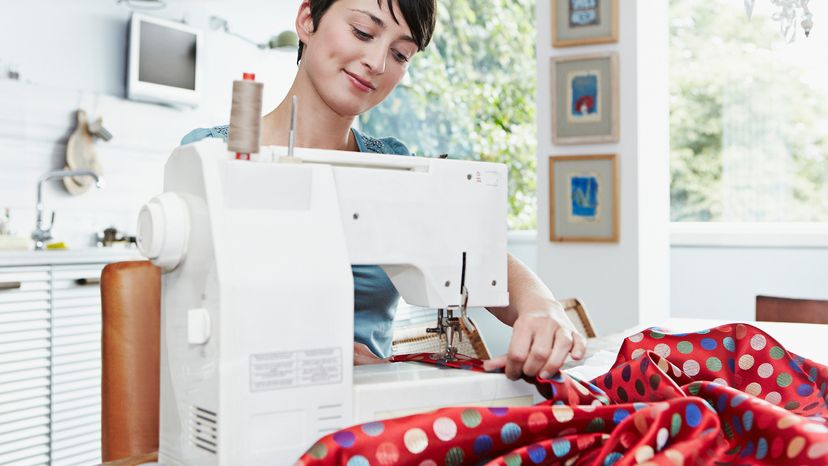Submitted by Michael Frankfort @mfrank_76
How Sewing Machines Work

MICHAEL HAEGELE / GETTY IMAGES
Without the sewing machine, the world would be a very different place. Like the automobile, the cotton gin and countless other innovations from the past 300 years, the sewing machine takes something time-consuming and laborious and makes it fast and easy. With the invention of the mechanized sewing machine, manufacturers could suddenly produce piles of high-quality clothing at minimal expense. Because of this technology, the vast majority of people in the world can now afford the sort of sturdy, finely-stitched clothes that were a luxury only 200 years ago.
In this article, we’ll take look at the remarkable machine that makes all of this possible. As it turns out, the automated stitching mechanism at the heart of a sewing machine is incredibly simple, though the machinery that drives it is fairly elaborate, relying on an assembly of gears, pulleys and motors to function properly. When you get down to it, the sewing machine is among the most elegant and ingenious tools ever created.
Sewing machines are something like cars: There are hundreds of models on the market, and they vary considerably in price and performance. At the low-end of the scale, there are conventional no-frills electric designs, ideal for occasional home use; at the high-end, there are sophisticated electronic machines that hook up to a computer. Textile companies have many machines to choose from, including streamlined models specifically designed to sew one particular product.
But just like cars, most sewing machines are built around one basic idea. Where the heart of a car is the internal combustion engine, the heart of a sewing machine is the loop stitching system.
The Loop Stitch
The loop stitch approach is very different from ordinary hand-sewing. In the simplest hand stitch, a length of thread is tied to a small eye at the end of a needle. The sewer passes the needle and the attached thread all the way through two pieces of fabric, from one side to the other and back again. In this way, the needle runs the thread in and out of the fabric pieces, binding them together.
While this is easy enough to do by hand, it is extremely difficult to pull off with a machine. The machine would have to release the needle on one side of the fabric just as it grabbed it again on the other side. Then it would have to pull the entire length of loose thread through the fabric, turn the needle around and do the whole thing in reverse. This process is way too complicated and unwieldy for a simple machine, and even by hand it only works well with short lengths of thread.
Instead, sewing machines pass the needle only part-way through the fabric. On a machine needle, the eye is right behind the sharp point, rather than at the end.
The needle is fastened to the needle bar, which is driven up and down by the motor via a series of gears and cams (more on this later).
When the point passes through the fabric, it pulls a small loop of thread from one side to the other. A mechanism underneath the fabric grabs this loop and wraps it around either another piece of thread or another loop in the same piece of thread.
There are actually several different types of loop stitches, and they all work a little differently.
Chain Stitch The simplest loop stitch is the chain stitch. To sew a chain stitch, the sewing machine loops a single length of thread back on itself.
The fabric, sitting on a metal plate underneath the needle, is held down by a presser foot. At the beginning of each stitch, the needle pulls a loop of thread through the fabric. A looper mechanism, which moves in synch with the needle, grabs the loop of thread before the needle pulls up. Once the needle has pulled out of the fabric, the feed dog mechanism (which we’ll examine later) pulls the fabric forward.
When the needle pushes through the fabric again, the new loop of thread passes directly through the middle of the earlier loop. The looper grabs the thread again and loops it around the next thread loop. In this way, every loop of thread holds the next loop in place.
The main advantage of the chain stitch is that it can be sewn very quickly. It is not especially sturdy, however, since the entire seam can come undone if one end of the thread is loosened. Most sewing machines use a sturdier stitch known as the lock stitch.
The most important element of a lock-stitch mechanism is the shuttle hook and bobbin assembly. The bobbin is just a spool of thread positioned underneath the fabric. It sits in the middle of a shuttle, which is rotated by the machine’s motor in synch with the motion of the needle.
Just as in a chain-stitch machine, the needle pulls a loop of thread through the fabric, rises again as the feed dogs move the fabric along, and then pushes another loop in. But instead of joining the different loops together, the stitching mechanism joins them to another length of thread that unspools from the bobbin.
When the needle pushes a loop through the thread, the rotary shuttle grips the loop with a hook. As the shuttle rotates, it pulls the loop around the thread coming from the bobbin. This makes for a very sturdy stitch.
